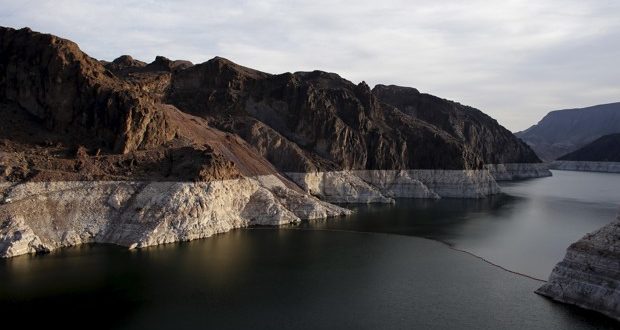Drought Transcends State Lines as U.S. West Turns Ever-More Arid
Published on May 12th, 2015
Alison Vekshin
May 11, 2015
Bloomberg Politics
The record drought plaguing California isn’t limited by lines on a map. Arid conditions caused by dwindling rainfall and snowpack are stretching across the West.
In Washington’s Yakima Valley, popular for growing wine grapes and beer hops, officials are cutting off water to about 1,700 farmers for three weeks starting today. At Lake Mead, east of Las Vegas, a 130-foot white band lines canyon walls as water sinks to the lowest since the reservoir was filled in 1937.
“California has gotten the attention, and rightly so,” said Roger Pulwarty, director of the National Integrated Drought Information System at the National Oceanic & Atmospheric Administration. “Across most of the West, dry conditions are expected to persist.”
“In the California and Nevada region, this is among the worst we’ve seen it in the last 120 years or so.”
Kelly Redmond
While droughts are common in the western U.S., climate change has led to longer and more frequent water shortages in recent years. Nine of the 10 warmest years since 1880 have been since 2000, according to NASA, diminishing mountain snowpacks — including in California and Nevada’s Sierra Nevada range — that supply most of the water in the western U.S.
The change suggests a permanent, drier future just as the center of the U.S. population moves steadily west to a region that’s already home to 55 million people. That’s prompting policy makers to consider extracting desalinated water from the Pacific Ocean, and forcing farmers in the nation’s most productive agricultural region to leave land unused and to dig deeper wells to reach groundwater.
Extra Dry
A severe drought grips almost 40 percent of the West, according to the U.S. Drought Monitor, a federal website.
Outside California, conditions are at their worst in neighboring Nevada. That state is followed by Oregon and Washington, said Kelly Redmond, a regional climatologist at the Western Regional Climate Center in Reno, Nevada.
“In the California and Nevada region, this is among the worst we’ve seen it in the last 120 years or so,” he said.
In Oregon, where 34 percent of the state is facing extreme drought, Governor Kate Brown declared emergencies in two counties last month, adding to five designated earlier this year.
Forty-seven percent of California, the most populous state, faces exceptional drought, the Drought Monitor’s highest rating. Regulators have required water suppliers to cut use as much as 36 percent starting next month.
The Bureau of Reclamation, the largest U.S. wholesale water supplier to farmers, residents and businesses, this week will start a program targeting 17 Western states. The program will provide $5 million to water districts, cities and tribes for projects, including infrastructure improvements to access water and set up water markets to match buyers and sellers.
In Washington’s Yakima Valley, Jim Willard will fallow 10 percent of his 500-acre farm, which produces grapes for about a dozen wineries, and apples exported to India and Indonesia.
“I’m very concerned about the effect this drought will have on not just this year’s crop but next year’s crop and my viability,” said Willard, 66, while sitting in his white pickup between his vineyard and orchard.
Willard’s farm is part of the Roza Irrigation District, where farmers are getting 47 percent of their usual federal allocation this year. Water is conserved for crops harvested later in the year, including hops, apples and wine grapes, said Scott Revell, the district manager.
“Because we don’t have a lot of rain, we need snow to melt and run off through June and July,” Revell said. “This year, it’s already gone.”
In Nevada, where the western half of the state bordering California is in extreme drought, lawmakers offered legislation in March to steer $500,000 to cloud seeding, a process that uses chemicals to stimulate clouds to produce rain.
‘New Norm’
At Lake Mead, about a 30 miles (48 kilometers) from the Las Vegas Strip, Gail Kaiser is moves her boat-slip rental business toward the water as it recedes. She said this month alone she’ll have to relocate three times, about 80 feet for each move.
“That’s kind of the new norm,” said Kaiser, 61, a manager at Las Vegas Boat Harbor, which includes 1,400 slips, two stores and two restaurants anchored to the lake bed.
The Southern Nevada Water Authority is building a three-mile (five-kilometer), $817 million tunnel under Lake Mead to retain access to its Colorado River supply as the reservoir declines to 40 percent of capacity, spokesman Bronson Mack said. The agency, which expects levels to keep declining in 2016 and 2017, also plans to build a $650 million pumping station to access water at deeper levels at the lake, which supplies 90 percent of southern Nevada’s water, he said.
“Our existing intakes could be sucking air,” Mack said.





